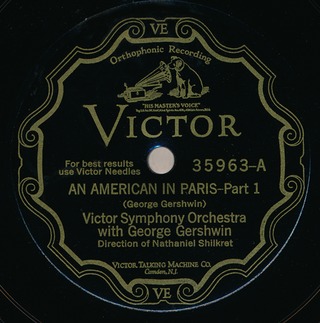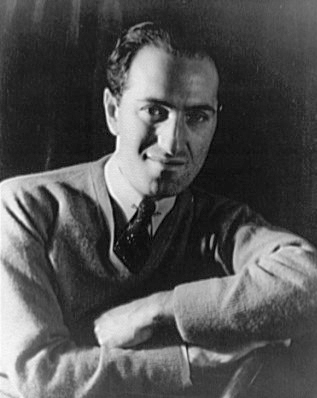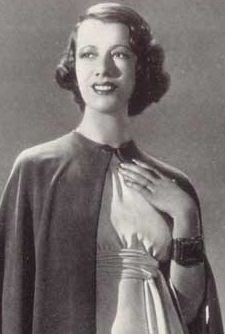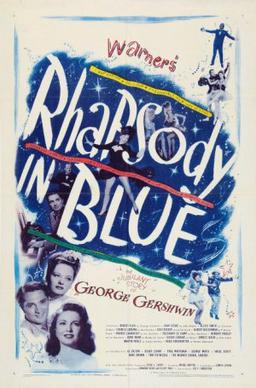Related Research Articles

An American in Paris is a jazz-influenced symphonic poem for orchestra by American composer George Gershwin first performed in 1928. It was inspired by the time that Gershwin had spent in Paris and evokes the sights and energy of the French capital during the Années folles.

George Gershwin was an American composer and pianist whose compositions spanned popular, jazz and classical genres. Among his best-known works are the orchestral compositions Rhapsody in Blue (1924) and An American in Paris (1928), the songs "Swanee" (1919) and "Fascinating Rhythm" (1924), the jazz standards "Embraceable You" (1928) and "I Got Rhythm" (1930), and the opera Porgy and Bess (1935), which included the hit "Summertime".

Rhapsody in Blue is a 1924 musical composition written by George Gershwin for solo piano and jazz band, which combines elements of classical music with jazz-influenced effects. Commissioned by bandleader Paul Whiteman, the work premiered in a concert titled "An Experiment in Modern Music" on February 12, 1924, in Aeolian Hall, New York City. Whiteman's band performed the rhapsody with Gershwin playing the piano. Whiteman's arranger Ferde Grofé orchestrated the rhapsody several times including the 1924 original scoring, the 1926 pit orchestra scoring, and the 1942 symphonic scoring.

Ferdinand Rudolph von Grofé, known as Ferde Grofé was an American composer, arranger, pianist and instrumentalist. He is best known for his 1931 five-movement symphonic poem, Grand Canyon Suite, and for having orchestrated George Gershwin's Rhapsody in Blue for its 1924 premiere.

Serge Koussevitzky was a Russian and American conductor, composer, and double-bassist, known for his long tenure as music director of the Boston Symphony Orchestra from 1924 to 1949.
Concerto in F is a composition by George Gershwin for solo piano and orchestra which is closer in form to a traditional concerto than his earlier jazz-influenced Rhapsody in Blue. It was written in 1925 on a commission from the conductor and director Walter Damrosch. It is just over half an hour long.

Robert Russell Bennett was an American composer and arranger, best known for his orchestration of many well-known Broadway and Hollywood musicals by other composers such as Irving Berlin, George Gershwin, Jerome Kern, Cole Porter, and Richard Rodgers.

Alice Joséphine Pons, known professionally as Lily Pons, was a French-American operatic lyric coloratura soprano and actress who had an active career from the late 1920s through the early 1970s. As an opera singer, she specialized in the coloratura soprano repertoire and was particularly associated with the title roles in Lakmé and Lucia di Lammermoor. In addition to appearing as a guest artist with many opera houses internationally, Pons enjoyed a long association with the Metropolitan Opera in New York City, where she performed nearly 300 times between 1931 and 1960.

Blue Monday was the original name of a one-act "jazz opera" by George Gershwin, renamed 135th Street during a later production. The English libretto was written by Buddy DeSylva. Though a short piece, with a running time of between twenty and thirty minutes, Blue Monday is often considered the blueprint to many of Gershwin's later works, and is often considered to be the "first piece of symphonic jazz" in that it was the first significant attempt to fuse forms of classical music such as opera with American popular music, with the opera largely influenced by Jazz and the African-American culture of Harlem.
Catfish Row, originally titled Suite from Porgy and Bess, is an orchestral work by George Gershwin based upon music from his famous opera Porgy and Bess. Gershwin completed the work in 1936 and it premiered at the Academy of Music in Philadelphia on January 21 of that year, with Alexander Smallens conducting the Philadelphia Orchestra. Gershwin played the piano part, including the piano solo in the opening moments. This piece preserves some of the darkest and most complex music Gershwin ever wrote.

Piano Concerto No. 4 in G minor, Op. 40, is a major work by Russian composer Sergei Rachmaninoff, completed in 1926. The work exists in three versions. Following its unsuccessful premiere, the composer made cuts and other amendments before publishing it in 1928. With continued lack of success, he withdrew the work, eventually revising and republishing it in 1941. The original manuscript version was released in 2000 by the Rachmaninoff Estate to be published and recorded. The work is dedicated to Nikolai Medtner, who in turn dedicated his Second Piano Concerto to Rachmaninoff the following year.

Shall We Dance is a 1937 American musical comedy film directed by Mark Sandrich. It is the seventh of the ten Fred Astaire-Ginger Rogers films. The story follows an American ballet dancer (Astaire) who falls in love with a tap dancer (Rogers); the tabloid press concocts a story of their marriage, after which life imitates art. George Gershwin wrote the symphonic underscore and Ira Gershwin the lyrics, for their second Hollywood musical.

Rhapsody in Blue, subtitled The story of George Gershwin is a 1945 American biographical film about composer and musician George Gershwin, released by Warner Brothers. Robert Alda stars as Gershwin. Joan Leslie, Alexis Smith, Hazel Scott, and Anne Brown also star, while Irving Rapper directs. The film was released in the United States on September 22, 1945.
Nadine Dana Suesse was an American musician, composer and lyricist.
Variations on "I Got Rhythm" is a set of variations for orchestra and piano solo composed by George Gershwin in 1933–34. The piece is dedicated "to [his] brother Ira".

Delicious (1931) is an American pre-Code Gershwin musical romantic comedy film starring Janet Gaynor and Charles Farrell, directed by David Butler, with color sequences in Multicolor.

Strike Up the Band is a 1927 musical with a book by Morrie Ryskind, lyrics by Ira Gershwin and music by George Gershwin. It first ran as a satirical show in Philadelphia that year, unsuccessfully, and on Broadway in 1930 after the original book by George S. Kaufman was revised by Ryskind. The show concerned a cheese manufacturer who sponsors a war against Switzerland because it will be named after him. Much of the satire of the 1927 version was replaced in the new version by silliness, leading Ryskind to recall, "What I had to do, in a sense, was to rewrite War and Peace for the Three Stooges." In the 1930 version the opening of Act I of the musical was reset from a cheese factory to a chocolate factory, and much of the work was a re-imagined as occurring during a dream sequence.
Rob Fisher is an American music director, conductor, arranger and pianist. He was the founding music director and conductor of the New York City Center Encores! series from 1994 to 2005. He is the leader of the Coffee Club Orchestra, which was the house band for Garrison Keillor’s radio broadcasts from 1989 to 1993.

Arias and Barcarolles is a 78-minute contemporary classical studio album of music by Leonard Bernstein, performed by Thomas Hampson, Frederica von Stade, Simon Carrington, Neil Percy and the London Symphony Orchestra under the direction of Michael Tilson Thomas. In addition to the song cycle which gives it its name, the album includes the Suite from Bernstein's opera A Quiet Place and the Symphonic Dances from his musical West Side Story. It was released in 1996.
References
- ↑ "George Gershwin". Encyclopædia Britannica.
- ↑ Goldberg, Isaac (1931). George Gershwin: A Study in American Music. Simon and Schuster.
- ↑ Wierzbicki, James (2007). "The Hollywood Career of Gershwin's Second Rhapsody". Journal of the American Musicological Society. 60 (1): 133–186. doi:10.1525/jams.2007.60.1.133. hdl: 2123/15851 . JSTOR 10.1525/jams.2007.60.1.133.
- ↑ Carnovale, Norbert (2000). George Gershwin: A Bio-Bibliography - Norbert Carnovale - Google Books. ISBN 9780313260032 . Retrieved 2012-08-04.
- ↑ Gershwin, George. "Gershwin Performs Gershwin: Rare Recordings 1931-1935" . Retrieved 1 November 2012.
- ↑ Michael Tilson Thomas Performs and Conducts Gershwin. "Michael Tilson Thomas Performs and Conducts Gershwin: Music" . Retrieved 2012-08-04.
- ↑ mencap.org.uk. "Mencap announces new classical concerts" . Retrieved 28 December 2013.
- ↑ "WQXR - New York's Classical Music Radio Station".
- ↑ "New, critical edition of George and Ira Gershwin's works to be compiled - The Rundown - PBS NewsHour". PBS NewsHour. 2013-09-14.
- ↑ "The Editions". Gershwin. 2013-09-08.
- ↑ "Musicology Now".
- Greenberg, Rodney (1998). George Gershwin. Phaidon Press. ISBN 0-7148-3504-8.